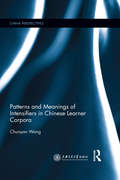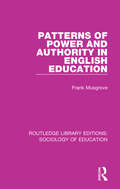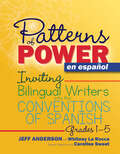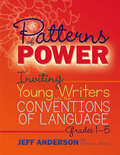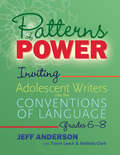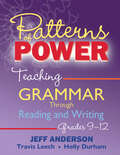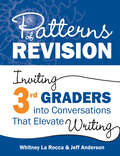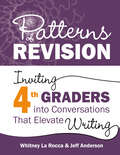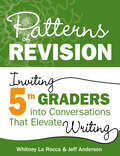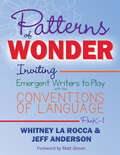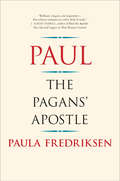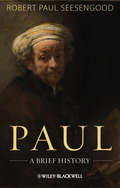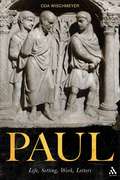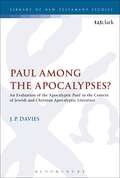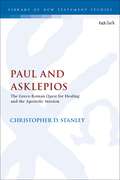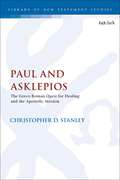- Table View
- List View
Patterns and Meanings of Intensifiers in Chinese Learner Corpora (China Perspectives)
by Chunyan WangIntensification plays a major role in spoken and written interaction, enabling the writer or speaker to express different levels of commitment. This book explores the patterns and meanings of intensifiers in Chinese learner English by ways of comparison with native English. The study is conducted within the theoretical framework of Firthian contextual theory of meaning, Sinclairian model of Extended Units of Meaning (EUM) and Hunston's pattern grammar. The method of contrastive inter-language analysis (CIA) is adopted and the intensifier collocations in learner English and native English are explored by means of quantitative and qualitative analyses of corpora data. This book is the first attempt to investigate the patterning and meaning features of intensifiers systematically with the corpora data in Chinese learner English. Readers will obtain a relatively complete picture of how Chinese learners use intensifiers to realize their attitudinal meanings.
Patterns of Power and Authority in English Education
by Frank MusgroveFirst published in 1971, this book argues that schools at the time were underpowered, due partly to circumstances within contemporary educational institutions, but chiefly to their relationships with the wider social environment. It suggests that schools lacked bargaining power and that their position deteriorated because they had marketed an ev
Patterns of Power and Authority in English Education
by Frank MusgroveFirst published in 1971, this book argues that schools at the time were underpowered, due partly to circumstances within contemporary educational institutions, but chiefly to their relationships with the wider social environment. It suggests that schools lacked bargaining power and that their position deteriorated because they had marketed an ev
Patterns of Power en español, Grades 1-5: Inviting Bilingual Writers into the Conventions of Spanish (Patterns of Power)
by Jeff Anderson Whitney La Rocca Caroline SweetAuthor Jeff Anderson and bilingual teacher and coach Caroline Sweet lead a vibrant approach to grammar instruction in Patterns of Power en español, Grades 1-5: Inviting Bilingual Writers into the Conventions of Spanish. Here, young, emergent writers are invited to notice the conventions of the Spanish language and build off them in this inquiry-based approach to instructional grammar. The book comes with standards-aligned lessons that can be incorporated in just 10 minutes a day. Patterns of Power’s responsive, invitational approach puts students in an involved role and has them explore and discuss the purpose and meaning of what they read. Students study short, authentic texts and are asked to share their findings out loud, engaging in rich conversations to make meaning. Inside you’ll find: Ready-to-use lesson plan sets that include excerpts from authentic and diverse Spanish mentor texts curated for grades 1-5 and can be adapted over 5 grade levels Real-life classroom examples, tips, and Power Notes gleaned from the authors’ experiences that can be applied to any level of writer Resources, including a Patterns of Power Planning Guide adapted for Spanish, to use in classroom instruction or as handouts for student literacy notebooks How to correlate to Spanish TEKS, Common Core, and other state standards Patterns of Power en español, Grades 1-5 provides a simple classroom routine that is structured in length and approach, but provides teachers flexibility in choosing the texts, allowing for numerous, diverse voices in the classroom. The practice helps students build cognitive recognition and provides a formative assessment for teachers on student progress. With these short lessons, students will gain confidence and move beyond limitation to produce effortless writing in your class and beyond. The Patterns of Power series also includes Patterns of Power, Grades 6-8: Inviting Adolescent Writers into the Conventions of Language; Patterns of Power, Grades 1-5: Inviting Young Writers into the Conventions of Language; Patterns of Power, Grades 9-12: Teaching Grammar Through Reading and Writing; and Patterns of Wonder, Grades PreK-1: Inviting Emergent Writers to Play with the Conventions of Language.
Patterns of Power en español, Grades 1-5: Inviting Bilingual Writers into the Conventions of Spanish (Patterns of Power)
by Jeff Anderson Whitney La Rocca Caroline SweetAuthor Jeff Anderson and bilingual teacher and coach Caroline Sweet lead a vibrant approach to grammar instruction in Patterns of Power en español, Grades 1-5: Inviting Bilingual Writers into the Conventions of Spanish. Here, young, emergent writers are invited to notice the conventions of the Spanish language and build off them in this inquiry-based approach to instructional grammar. The book comes with standards-aligned lessons that can be incorporated in just 10 minutes a day. Patterns of Power’s responsive, invitational approach puts students in an involved role and has them explore and discuss the purpose and meaning of what they read. Students study short, authentic texts and are asked to share their findings out loud, engaging in rich conversations to make meaning. Inside you’ll find: Ready-to-use lesson plan sets that include excerpts from authentic and diverse Spanish mentor texts curated for grades 1-5 and can be adapted over 5 grade levels Real-life classroom examples, tips, and Power Notes gleaned from the authors’ experiences that can be applied to any level of writer Resources, including a Patterns of Power Planning Guide adapted for Spanish, to use in classroom instruction or as handouts for student literacy notebooks How to correlate to Spanish TEKS, Common Core, and other state standards Patterns of Power en español, Grades 1-5 provides a simple classroom routine that is structured in length and approach, but provides teachers flexibility in choosing the texts, allowing for numerous, diverse voices in the classroom. The practice helps students build cognitive recognition and provides a formative assessment for teachers on student progress. With these short lessons, students will gain confidence and move beyond limitation to produce effortless writing in your class and beyond. The Patterns of Power series also includes Patterns of Power, Grades 6-8: Inviting Adolescent Writers into the Conventions of Language; Patterns of Power, Grades 1-5: Inviting Young Writers into the Conventions of Language; Patterns of Power, Grades 9-12: Teaching Grammar Through Reading and Writing; and Patterns of Wonder, Grades PreK-1: Inviting Emergent Writers to Play with the Conventions of Language.
Patterns of Power, Grades 1-5: Inviting Young Writers into the Conventions of Language (Patterns of Power)
by Jeff Anderson Whitney La RoccaAuthor Jeff Anderson and literacy coach Whitney La Rocca lead a vibrant approach to grammar instruction in Patterns of Power, Grades 1-5: Inviting Young Writers into the Conventions of Language. Here, young, emergent writers are invited to notice the conventions of the English language and build off them in this inquiry-based approach to instructional grammar. The book comes with standards-aligned lessons that can be incorporated in 10 minutes a day. Patterns of Power’s responsive, invitational approach puts students in an involved role and has them explore and discuss the purpose and meaning of what they read. Students study short, authentic texts and are asked to share their findings out loud, engaging in rich conversations to make meaning. Inside you’ll find: Ready-to-use lesson plan sets that include excerpts from authentic and diverse mentor texts curated for grades 1-5 and can be adapted over 5 grade levels Real-life classroom examples, tips, and Power Notes gleaned from the authors’ experiences that can be applied to any level of writer Resources, including a Patterns of Power Planning Guide and musical soundtracks, to use in classroom instruction or as handouts for student literacy notebooks Patterns of Power, Grades 1-5 provides a simple classroom routine that is structured in length and approach, but provides teachers flexibility in choosing the texts, allowing for numerous, diverse voices in the classroom. The practice helps students build cognitive recognition and provides a formative assessment for teachers on student progress. With these short lessons, students will grow their confidence and move beyond limitation to produce effortless writing in your class and beyond. The Patterns of Power series also includes Patterns of Power, Grades 6-8: Inviting Adolescent Writers into the Conventions of Language; Patterns of Power en Español, Grades 1-5: Inviting Bilingual Writers into the Conventions of Spanish; Patterns of Power, Grades 9-12: Teaching Grammar Through Reading and Writing and Patterns of Wonder, Grades PreK-1: Inviting Emergent Writers to Play with the Conventions of Language.
Patterns of Power, Grades 1-5: Inviting Young Writers into the Conventions of Language (Patterns of Power)
by Jeff Anderson Whitney La RoccaAuthor Jeff Anderson and literacy coach Whitney La Rocca lead a vibrant approach to grammar instruction in Patterns of Power, Grades 1-5: Inviting Young Writers into the Conventions of Language. Here, young, emergent writers are invited to notice the conventions of the English language and build off them in this inquiry-based approach to instructional grammar. The book comes with standards-aligned lessons that can be incorporated in 10 minutes a day. Patterns of Power’s responsive, invitational approach puts students in an involved role and has them explore and discuss the purpose and meaning of what they read. Students study short, authentic texts and are asked to share their findings out loud, engaging in rich conversations to make meaning. Inside you’ll find: Ready-to-use lesson plan sets that include excerpts from authentic and diverse mentor texts curated for grades 1-5 and can be adapted over 5 grade levels Real-life classroom examples, tips, and Power Notes gleaned from the authors’ experiences that can be applied to any level of writer Resources, including a Patterns of Power Planning Guide and musical soundtracks, to use in classroom instruction or as handouts for student literacy notebooks Patterns of Power, Grades 1-5 provides a simple classroom routine that is structured in length and approach, but provides teachers flexibility in choosing the texts, allowing for numerous, diverse voices in the classroom. The practice helps students build cognitive recognition and provides a formative assessment for teachers on student progress. With these short lessons, students will grow their confidence and move beyond limitation to produce effortless writing in your class and beyond. The Patterns of Power series also includes Patterns of Power, Grades 6-8: Inviting Adolescent Writers into the Conventions of Language; Patterns of Power en Español, Grades 1-5: Inviting Bilingual Writers into the Conventions of Spanish; Patterns of Power, Grades 9-12: Teaching Grammar Through Reading and Writing and Patterns of Wonder, Grades PreK-1: Inviting Emergent Writers to Play with the Conventions of Language.
Patterns of Power, Grades 6–8: Inviting Adolescent Writers into the Conventions of Language (Patterns of Power)
by Jeff Anderson Travis Leech Melinda ClarkAuthors Jeff Anderson, Travis Leech, and Melinda Clark lead a vibrant approach to grammar instruction in Patterns of Power, Grades 6-8: Inviting Adolescent Writers into the Conventions of Language. Here, young, emergent writers are invited to notice the conventions of the English language and build off them in this inquiry-based approach to instructional grammar. The book comes with standards-aligned lessons that can be incorporated in just 10 minutes a day. Patterns of Power’s responsive, invitational approach puts students in an involved role and has them explore and discuss the purpose and meaning of what they read. Students study short, authentic texts and are asked to share their findings out loud, engaging in rich conversations to make meaning. Inside you’ll find: Ready-to-use lesson plan sets that include excerpts from authentic and diverse mentor texts curated for grades 6-8 Real-life classroom examples, tips, and Power Notes gleaned from the authors’ experiences that can be applied to any level of writer Resources, including a Patterns of Power Planning Guide and musical soundtracks, to use in classroom instruction or as handouts for student literacy notebooks Patterns of Power, Grades 6-8 provides a simple classroom routine that is structured in length and approach, but provides teachers flexibility in choosing the texts, allowing for numerous, diverse voices in the classroom. The practice helps students build cognitive recognition and provides a formative assessment for teachers on student progress. With these short lessons, students will gain confidence and move beyond limitation to produce effortless writing in your class and beyond. The Patterns of Power series also includes Patterns of Power, Grades 1-5: Inviting Young Writers into the Conventions of Language; Patterns of Power en Español, Grades 1-5: Inviting Bilingual Writers into the Conventions of Spanish; Patterns of Power, Grades 9-12: Teaching Grammar Through Reading and Writing; and Patterns of Wonder, Grades PreK-1: Inviting Emergent Writers to Play with the Conventions of Language.
Patterns of Power, Grades 6–8: Inviting Adolescent Writers into the Conventions of Language (Patterns of Power)
by Jeff Anderson Travis Leech Melinda ClarkAuthors Jeff Anderson, Travis Leech, and Melinda Clark lead a vibrant approach to grammar instruction in Patterns of Power, Grades 6-8: Inviting Adolescent Writers into the Conventions of Language. Here, young, emergent writers are invited to notice the conventions of the English language and build off them in this inquiry-based approach to instructional grammar. The book comes with standards-aligned lessons that can be incorporated in just 10 minutes a day. Patterns of Power’s responsive, invitational approach puts students in an involved role and has them explore and discuss the purpose and meaning of what they read. Students study short, authentic texts and are asked to share their findings out loud, engaging in rich conversations to make meaning. Inside you’ll find: Ready-to-use lesson plan sets that include excerpts from authentic and diverse mentor texts curated for grades 6-8 Real-life classroom examples, tips, and Power Notes gleaned from the authors’ experiences that can be applied to any level of writer Resources, including a Patterns of Power Planning Guide and musical soundtracks, to use in classroom instruction or as handouts for student literacy notebooks Patterns of Power, Grades 6-8 provides a simple classroom routine that is structured in length and approach, but provides teachers flexibility in choosing the texts, allowing for numerous, diverse voices in the classroom. The practice helps students build cognitive recognition and provides a formative assessment for teachers on student progress. With these short lessons, students will gain confidence and move beyond limitation to produce effortless writing in your class and beyond. The Patterns of Power series also includes Patterns of Power, Grades 1-5: Inviting Young Writers into the Conventions of Language; Patterns of Power en Español, Grades 1-5: Inviting Bilingual Writers into the Conventions of Spanish; Patterns of Power, Grades 9-12: Teaching Grammar Through Reading and Writing; and Patterns of Wonder, Grades PreK-1: Inviting Emergent Writers to Play with the Conventions of Language.
Patterns of Power, Grades 9-12: Teaching Grammar Through Reading and Writing
by Jeff Anderson Travis Leech Holly DurhamTraditional grammar instruction often focuses too much on what’s right or what’s wrong, hiding the true power of conventions—the creation of meaning, purpose, and effect. Instead of hammering high school students with the mistakes they should avoid, Jeff Anderson, Travis Leech, and Holly Durham suggest exploring grammar through the celebration of author’s purpose and craft. In Patterns of Power, Grades 9-12: Teaching Grammar Through Reading and Writing, they invite you to create an environment in which writers thrive while studying and appreciating the beauty, effects, and meaning of grammar. Inside this book, teachers will find a comprehensive explanation of the brain-based Patterns of Power invitational process, as well as: 35 standards-aligned lesson sets built around practical, engaging, inquiry-based methods that take deeper dives into grammar and craft than any worksheet, quiz, or editing exercise ever could A variety of high-interest model texts from authentic and diverse sources, including excerpts from classic and current novels, memoirs, plays, graphic novels, poems, and media Real-life classroom examples and tips with suggestions for scaffolding new learning and ideas for how to use the lessons in AP courses Templates for extended application, easy to locate printables, and ready-to-go visuals Additional Models for Further Study for extension opportunities in every lesson set An entire chapter devoted to helping high school writers master citations in research With hundreds of teach-tomorrow resources and implementation supports such as quick-reference guides, specific applications to reading instruction, and soundtrack suggestions to infuse the joy of music into grammar instruction, Patterns of Power, Grades 9-12 gives you everything you need to inspire your high school writers to move beyond limitation and into the endless possibilities of what they can do as writers. The Patterns of Power series also includes Patterns of Power, Grades 6-8: Inviting Adolescent Writers into the Conventions of Language; Patterns of Power, Grades 1-5: Inviting Young Writers into the Conventions of Language; Patterns of Wonder, Grades PreK-1: Inviting Emergent Writers to Play with the Conventions of Language; and Patterns of Power en Español, Grades 1-5: Inviting Bilingual Writers into the Conventions of Spanish.
Patterns of Power, Grades 9-12: Teaching Grammar Through Reading and Writing
by Jeff Anderson Travis Leech Holly DurhamTraditional grammar instruction often focuses too much on what’s right or what’s wrong, hiding the true power of conventions—the creation of meaning, purpose, and effect. Instead of hammering high school students with the mistakes they should avoid, Jeff Anderson, Travis Leech, and Holly Durham suggest exploring grammar through the celebration of author’s purpose and craft. In Patterns of Power, Grades 9-12: Teaching Grammar Through Reading and Writing, they invite you to create an environment in which writers thrive while studying and appreciating the beauty, effects, and meaning of grammar. Inside this book, teachers will find a comprehensive explanation of the brain-based Patterns of Power invitational process, as well as: 35 standards-aligned lesson sets built around practical, engaging, inquiry-based methods that take deeper dives into grammar and craft than any worksheet, quiz, or editing exercise ever could A variety of high-interest model texts from authentic and diverse sources, including excerpts from classic and current novels, memoirs, plays, graphic novels, poems, and media Real-life classroom examples and tips with suggestions for scaffolding new learning and ideas for how to use the lessons in AP courses Templates for extended application, easy to locate printables, and ready-to-go visuals Additional Models for Further Study for extension opportunities in every lesson set An entire chapter devoted to helping high school writers master citations in research With hundreds of teach-tomorrow resources and implementation supports such as quick-reference guides, specific applications to reading instruction, and soundtrack suggestions to infuse the joy of music into grammar instruction, Patterns of Power, Grades 9-12 gives you everything you need to inspire your high school writers to move beyond limitation and into the endless possibilities of what they can do as writers. The Patterns of Power series also includes Patterns of Power, Grades 6-8: Inviting Adolescent Writers into the Conventions of Language; Patterns of Power, Grades 1-5: Inviting Young Writers into the Conventions of Language; Patterns of Wonder, Grades PreK-1: Inviting Emergent Writers to Play with the Conventions of Language; and Patterns of Power en Español, Grades 1-5: Inviting Bilingual Writers into the Conventions of Spanish.
Patterns of Revision, Grade 3: Inviting 3rd Graders into Conversations That Elevate Writing (Patterns of Revision)
by Jeff Anderson Whitney La RoccaWith every lesson grounded in the critical strategy of writers talking out their revisions, Patterns of Revision will establish routines, practices, and mindsets to set you and your students up for success from day one. Discover the joy inherent in writing - and writing instruction - when we explore revision through engaging inquiry and the study of models, building flexible, competent revisors, step-by-step, in an open-ended discussion of meaning driven revision choices and their effects.
Patterns of Revision, Grade 4: Inviting 4th Graders into Conversations That Elevate Writing
by Whitney La Rocca Jeff AndersonHow do we get fourth-grade writers to revise? And once we do get them thinking about revision, what, exactly, do they do? What do we do? In Patterns of Revision, best-selling authors Whitney La Rocca and Jeff Anderson answer these questions and more. This practical resource uses the research-proven and classroom-tested methods of sentence combining in a meaningful, engaging way that supports authentic writing as well as writing for performance-based or multiple-choice tests. Flip the book open to immediately find: • The DRAFT mnemonic to help students know where to begin the revision process and how to keep going • Concrete, doable lessons that spark academic conversations (oral rehearsal and play) about meaning, effect, and purpose that are grounded in a student-centered revision approach • Easily accessed display and printable pages to seamlessly support student revision learning, embedded in each lesson right where you need it • Authentic and engaging model text excerpts curated to support each lesson • An engaging process for revision instruction that can be immediately implemented to support any writing approach or as a supplemental resource for Patterns of Power, 1-5 as well as Patterns of Power Plus, Grade 4 With every lesson grounded in the critical strategy of writers talking out their revisions, Patterns of Revision will establish routines, practices, and mindsets to set up you and your students for success from Day 1. Discover the joy inherent in writing—and writing instruction—by exploring revision through engaging inquiry and the study of models, building flexible, competent revisors, step-by-step, in an open-ended discussion of meaning-driven revision choices and their effects.
Patterns of Revision, Grade 5: Inviting 5th Graders into Conversations That Elevate Writing
by Whitney La Rocca Jeff AndersonHow do we get fifth-grade writers to revise? And once we do get them thinking about revision, what, exactly, do they do? What do we do? In Patterns of Revision, best-selling authors Whitney La Rocca and Jeff Anderson answer these questions and more. This practical resource uses the research-proven and classroom-tested methods of sentence combining in a meaningful, engaging way that supports authentic writing as well as writing for performance-based or multiple-choice tests. Flip the book open to immediately find: • The DRAFT mnemonic to help students know where to begin the revision process and how to keep going • Concrete, doable lessons that spark academic conversations (oral rehearsal and play) about meaning, effect, and purpose that are grounded in a student-centered revision approach • Easily accessed display and printable pages to seamlessly support student revision learning, embedded in each lesson right where you need it • Authentic and engaging model text excerpts curated to support each lesson • An engaging process for revision instruction that can be immediately implemented to support any writing approach or as a supplemental resource for Patterns of Power, 1-5 as well as Patterns of Power Plus, Grade 5 With every lesson grounded in the critical strategy of writers talking out their revisions, Patterns of Revision will establish routines, practices, and mindsets to set up you and your students for success from Day 1. Discover the joy inherent in writing—and writing instruction—by exploring revision through engaging inquiry and the study of models, building flexible, competent revisors, step-by-step, in an open-ended discussion of meaning-driven revision choices and their effects.
Patterns of Wonder, Grades PreK-1: Inviting Emergent Writers to Play with the Conventions of Language
by Whitney La Rocca Jeff AndersonWhitney La Rocca and Jeff Anderson adapt their vibrant approach to grammar instruction in Patterns of Wonder, Grades Prek-1: Inviting Emergent Writers to Play with the Conventions of Language. Here, young, emergent writers are invited to notice the conventions of language and build off them in this inquiry-based approach to instructional grammar. The book comes with standards-aligned lessons that can be incorporated in just 10 minutes a day. Patterns of Wonder’s responsive, invitational approach allows young students to play and inquire about language and experiment, take risks, and have fun. Inside you’ll find: Ready-to-use lesson plan sets that pinpoint and build across the most common needs of emergent writers An adjusted invitational process adapted for young learners, and the Phases of Emergent Writing as tools to plan for effective, scaffolded instruction How to position grammar concepts about print instruction across three overlapping levels of support: oral language, illustrating, and writing Over 200 engaging picture book recommendations to stir curious classroom conversations Patterns of Wonder, Grades PreK-1 provides a simple classroom routine that is structured in length and approach, but provides teachers flexibility in choosing the texts, allowing for numerous, diverse voices in the classroom. The practice helps students build cognitive recognition and provides a formative assessment for teachers on student progress. Grounded in play, conversation, and most of all, wonder, Patterns of Wonder brings the authors’ irrepressible excitement for inquiry and writing instruction to the ways we support our Pre-K, Kindergarten and 1st grade emergent writers. The Patterns of Power series also includes Patterns of Power, Grades 6-8: Inviting Adolescent Writers into the Conventions of Language; Patterns of Power, Grades 1-5: Inviting Young Writers into the Conventions of Language; Patterns of Power, Grades 9-12: Teaching Grammar Through Reading and Writing; and Patterns of Power en Español. Grades 1-5: Inviting Bilingual Writers into the Conventions of Spanish.
Patterns of Wonder, Grades PreK-1: Inviting Emergent Writers to Play with the Conventions of Language
by Whitney La Rocca Jeff AndersonWhitney La Rocca and Jeff Anderson adapt their vibrant approach to grammar instruction in Patterns of Wonder, Grades Prek-1: Inviting Emergent Writers to Play with the Conventions of Language. Here, young, emergent writers are invited to notice the conventions of language and build off them in this inquiry-based approach to instructional grammar. The book comes with standards-aligned lessons that can be incorporated in just 10 minutes a day. Patterns of Wonder’s responsive, invitational approach allows young students to play and inquire about language and experiment, take risks, and have fun. Inside you’ll find: Ready-to-use lesson plan sets that pinpoint and build across the most common needs of emergent writers An adjusted invitational process adapted for young learners, and the Phases of Emergent Writing as tools to plan for effective, scaffolded instruction How to position grammar concepts about print instruction across three overlapping levels of support: oral language, illustrating, and writing Over 200 engaging picture book recommendations to stir curious classroom conversations Patterns of Wonder, Grades PreK-1 provides a simple classroom routine that is structured in length and approach, but provides teachers flexibility in choosing the texts, allowing for numerous, diverse voices in the classroom. The practice helps students build cognitive recognition and provides a formative assessment for teachers on student progress. Grounded in play, conversation, and most of all, wonder, Patterns of Wonder brings the authors’ irrepressible excitement for inquiry and writing instruction to the ways we support our Pre-K, Kindergarten and 1st grade emergent writers. The Patterns of Power series also includes Patterns of Power, Grades 6-8: Inviting Adolescent Writers into the Conventions of Language; Patterns of Power, Grades 1-5: Inviting Young Writers into the Conventions of Language; Patterns of Power, Grades 9-12: Teaching Grammar Through Reading and Writing; and Patterns of Power en Español. Grades 1-5: Inviting Bilingual Writers into the Conventions of Spanish.
Paul: The Pagan's Apostle
by Paula FredriksenA groundbreaking new portrait of the apostle Paul, from one of today’s leading historians of antiquity Often seen as the author of timeless Christian theology, Paul himself heatedly maintained that he lived and worked in history’s closing hours. His letters propel his readers into two ancient worlds, one Jewish, one pagan. The first was incandescent with apocalyptic hopes, expecting God through his messiah to fulfill his ancient promises of redemption to Israel. The second teemed with ancient actors, not only human but also divine: angry superhuman forces, jealous demons, and hostile cosmic gods. Both worlds are Paul’s, and his convictions about the first shaped his actions in the second. Only by situating Paul within this charged social context of gods and humans, pagans and Jews, cities, synagogues, and competing Christ-following assemblies can we begin to understand his mission and message. This original and provocative book offers a dramatically new perspective on one of history’s seminal figures.
Paul: The Man And The Myth
by Calvin J. RoetzelWinner of 'New Testament Book of the Year, Biblical Archaeology Society 1999' A masterly new evaluation of Paul: the man, his work and his world. Professor Roetzel breaks new ground in exploring some aspects of Paul which have remained shadowy: his sexual asceticism, his preoccupation with holiness - Holy Spirit, holy community and holy ethos - the evolution of his theology, and his emergence as a legendary figure. Roetzel also furthers our understanding of the culture, the social world and the political realities of Paul's time.
Paul: A Brief History (Wiley Blackwell Brief Histories of Religion)
by Robert Paul SeesengoodSeesengood traces the life and impact of Paul – one of Christianity’s most influential figures – through the major periods Christian history. Exploring the changing interpretations of Paul and his work, the author throws new light on his writings and on religious history. Offers a unique, insightful journey through the many and varied interpretations of Paul’s life and work over 2,000 years – from the Gnostic controversy, to Luther and the Reformation, to contemporary debates over religion and science Explains Paul’s pivotal role within Christian history, and how his missionary journeys, canonized epistles and theological insights were cornerstones of the early Church and central to the formation of Christian doctrine Argues that each new interpretation of Paul is the result of a fresh set of cultural, social and ideological circumstances – and so questions whether it is ever possible to discover the real Paul
Paul: Life, Setting, Work, Letters
by Oda WischmeyerThis new work aimed at upper level undergraduates provides an invaluable handbook for students seriously engaging with Paul's life, letters and context. This new coursebook assesses Paul from four key areas. This book is written by several co-authors, all experts in their given fields, to give the most up-to-date and accurate information to readers - but also to present a sense of authorial continuity throughout the book. This book is divided into three main parts; the environment, life, work and person of Paul; Paul's letters and theological themes; and, the reception of Paul and his letters. As such it provides a comprehensive overview of scholarship on Paul and is the perfect handbook for the serious student wishing to engage with some of the most important writings in the New Testament. This book features maps, tables, text-boxes, up-to-date bibliographies and key points are identified throughout.
Paul: Life, Setting, Work, Letters (Beihefte Zur Zeitschrift Für Die Neutestamentliche Wissenschaft Ser. #198)
by Oda WischmeyerThis new work aimed at upper level undergraduates provides an invaluable handbook for students seriously engaging with Paul's life, letters and context. This new coursebook assesses Paul from four key areas. This book is written by several co-authors, all experts in their given fields, to give the most up-to-date and accurate information to readers - but also to present a sense of authorial continuity throughout the book. This book is divided into three main parts; the environment, life, work and person of Paul; Paul's letters and theological themes; and, the reception of Paul and his letters. As such it provides a comprehensive overview of scholarship on Paul and is the perfect handbook for the serious student wishing to engage with some of the most important writings in the New Testament. This book features maps, tables, text-boxes, up-to-date bibliographies and key points are identified throughout.
Paul Among the Apocalypses?: An Evaluation of the ‘Apocalyptic Paul’ in the Context of Jewish and Christian Apocalyptic Literature (The Library of New Testament Studies)
by Dr J. P. DaviesA vibrant and growing field of discussion in contemporary New Testament studies is the question of 'apocalyptic' thought in Paul. What is often lacking in this discussion, however, is a close comparison of Paul's would-be apocalyptic theology with the Jewish and Christian apocalyptic literature of his time, and the worldview that literature expresses. This book addresses that challenge. Covering four key theological themes (epistemology, eschatology, cosmology and soteriology), J. P. Davies places Paul 'among the apocalypses' in order to evaluate recent attempts at outlining an 'apocalyptic' approach to his letters. While affirming much of what those approaches have argued, and agreeing that 'apocalyptic' is a crucial category for an understanding of the apostle, Davies also raises some important questions about the dichotomies which lie at the heart of the 'apocalyptic Paul' movement.
Paul Among the Apocalypses?: An Evaluation of the ‘Apocalyptic Paul’ in the Context of Jewish and Christian Apocalyptic Literature (The Library of New Testament Studies #562)
by J. P. DaviesA vibrant and growing field of discussion in contemporary New Testament studies is the question of 'apocalyptic' thought in Paul. What is often lacking in this discussion, however, is a close comparison of Paul's would-be apocalyptic theology with the Jewish and Christian apocalyptic literature of his time, and the worldview that literature expresses. This book addresses that challenge. Covering four key theological themes (epistemology, eschatology, cosmology and soteriology), J. P. Davies places Paul 'among the apocalypses' in order to evaluate recent attempts at outlining an 'apocalyptic' approach to his letters. While affirming much of what those approaches have argued, and agreeing that 'apocalyptic' is a crucial category for an understanding of the apostle, Davies also raises some important questions about the dichotomies which lie at the heart of the 'apocalyptic Paul' movement.
Paul and Asklepios: The Greco-Roman Quest for Healing and the Apostolic Mission (The Library of New Testament Studies)
by Christopher D. StanleyWhat role did offers of physical healing (or the hope of receiving it) play in the missionary program of the apostle Paul? What did he do to treat the many illnesses and injuries that he endured while pursuing his mission? What did he advise his followers to do regarding their health problems? Such questions have been broadly neglected in studies of Paul and his churches, but Christopher D. Stanley shows how vital they truly become once we recognize how thoroughly “pagan” religion was implicated in all aspects of Greco-Roman health care. What did Paul approve, and what did he reject?Given Paul's silence on these subjects, Stanley relies on a cross-cultural and interdisciplinary approach to develop informed judgments about what Paul might have thought, said, and done with regard to his own and his followers' health care. He begins by exploring the nature and extent of sickness in the Roman world and the four overlapping health care systems that were available to Paul and his followers: home remedies, “magical” treatments, religious healing, and medical care. He then examines how Judeans and Christians in the centuries before and after Paul viewed and engaged with these systems. Finally, he speculates on what kinds of treatments Paul might have approved or rejected and whether he might have used promises of healing to attract people to his movement. The result is a thorough and nuanced analysis of a vital dimension of Greco-Roman social life and Paul's place within it.
Paul and Asklepios: The Greco-Roman Quest for Healing and the Apostolic Mission (The Library of New Testament Studies)
by Christopher D. StanleyWhat role did offers of physical healing (or the hope of receiving it) play in the missionary program of the apostle Paul? What did he do to treat the many illnesses and injuries that he endured while pursuing his mission? What did he advise his followers to do regarding their health problems? Such questions have been broadly neglected in studies of Paul and his churches, but Christopher D. Stanley shows how vital they truly become once we recognize how thoroughly “pagan” religion was implicated in all aspects of Greco-Roman health care. What did Paul approve, and what did he reject?Given Paul's silence on these subjects, Stanley relies on a cross-cultural and interdisciplinary approach to develop informed judgments about what Paul might have thought, said, and done with regard to his own and his followers' health care. He begins by exploring the nature and extent of sickness in the Roman world and the four overlapping health care systems that were available to Paul and his followers: home remedies, “magical” treatments, religious healing, and medical care. He then examines how Judeans and Christians in the centuries before and after Paul viewed and engaged with these systems. Finally, he speculates on what kinds of treatments Paul might have approved or rejected and whether he might have used promises of healing to attract people to his movement. The result is a thorough and nuanced analysis of a vital dimension of Greco-Roman social life and Paul's place within it.
